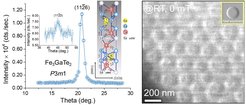Above room-temperature stable chiral magnetic nano-vortices in a self-intercalated 2D van der Waals Magnet
Physicists at the Max Planck Institute of Microstructure Physics demonstrated that in the 2D van der Waals magnet Fe3GaTe2, chiral Néel-type skyrmions are stable well above room temperature. The study also details the mechanisms related to the self-intercalation of Fe atoms, which could pave the way for developing high-temperature 2D van der Waals spintronic devices.
Researchers from the Max-Planck Institute of Microstructure Physics, Martin-Luther-Universität Halle-Wittenberg, and the Indian Institute of Science Education & Research, Tirupati, have discovered a two-dimensional (2D) van der Waals (vdW) magnet that features chiral nano-magnetic objects stable up to 340 K. These findings hold promise for novel spintronic applications and pave the way for designing vdW magnets that maintain their magnetic properties at high temperatures. The study is published in npj Spintronics - Nature.
Recent research has sparked significant interest in the scientific community concerning 2D magnetic systems, especially within the vdW family of materials. A key area of focus is the study of skyrmions—tiny, non-collinear chiral spin structures with promising applications in spintronics and quantum computing. Skyrmions are typically found in magnetic materials that lack a center of symmetry. For practical applications, it is essential that these materials exhibit magnetism at room temperature or higher, a challenge that researchers have been working hard to address.
The study published on June 3rd in the journal npj Spintronics by researchers from the NISE department (Nano-Systems from Ions, Spins and Electrons) at the Max-Planck Institute of Microstructure Physics provides clear evidence for the formation of chiral skyrmions in a vdW magnet, Fe3GaTe2 (FGaT). Previously thought to be centrosymmetric, FGaT is now found to have a non-centrosymmetric structure due to vacancies in the Fe sublattice, atomic position relaxations, and Fe intercalation into the vdW gaps. These discoveries were made through precise X-ray diffraction analyses. FGaT, structurally similar to Fe3GeTe2 (FGT), which has a lower magnetic ordering temperature (~220 K), maintains its magnetic long-range order up to 370 K, the highest known temperature for vdW magnets. The high concentration of Fe intercalation is suggested to contribute to the material's stability of magnetic order at elevated temperatures. The non-centrosymmetric structure is crucial for the stabilization of Néel skyrmions, which were directly observed using Lorentz transmission electron microscopy. Rana Saha, the first author of the paper, comments, "Our discovery is expected to significantly influence the scientific community studying 2D vdW systems, especially in advancing high-temperature spintronics with these unique materials. Subtle structural changes, such as self-intercalation and vacancies, previously overlooked, are now found to play a crucial role in determining the physical properties of 2D vdW magnets."

Abstract
Two-dimensional (2D) van der Waals (vdW) magnets that exhibit ferromagnetism at ambient temperature show great promise for spintronic applications. However, until now, only a few pristine or doped 2D magnets have demonstrated the ability to host non-collinear spin textures, thereby limiting their potential applications. Here we directly observe Néel-type skyrmions in the metallic vdW magnetic compound Fe3GaTe2 (FGaT) up to temperatures well above room temperature (≈340 K) in the absence of any external magnetic field. We show that the presence of defects in the structure of FGaT make its structure acentric and therefore compatible with hosting skyrmions that would otherwise not be possible. Indeed, in this regard it is very similar to the closely related compound Fe3GeTe2 (FGT), whose structure with the same space group P3m1 is also realized by defects. Interestingly, however, FGaT accommodates a significantly higher concentration of Fe within the vdW gaps, likely accounting for its enhanced Curie temperature (TC). In addition to the Néel skyrmions observed in the temperature range of 250–340 K, we also detect type-I and -II Bloch-type skyrmionic bubbles in the temperature range of 100–200 K due to an enhanced magnitude of dipole-dipole interactions relative to the Dzyaloshinskii-Moriya exchange interaction. Self-intercalation is thus a highly interesting property of vdW magnets that considerably modifies their fundamental properties.












